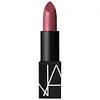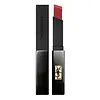What's inside
What's inside
 Key Ingredients
Key Ingredients

 Benefits
Benefits

 Concerns
Concerns

 Ingredients Side-by-side
Ingredients Side-by-side

Dimethicone
EmollientSynthetic Wax
AbrasivePolyethylene
AbrasiveIsohexadecane
EmollientHydrogenated Polyisobutene
EmollientDimethicone/Vinyl Dimethicone Crosspolymer
Skin ConditioningMicrocrystalline Wax
Emulsion StabilisingKaolin
AbrasiveEuphorbia Cerifera Wax
Sorbitan Sesquiisostearate
EmulsifyingCetearyl Dimethicone Crosspolymer
Tocopheryl Acetate
AntioxidantPassiflora Edulis Seed Oil
EmollientMoringa Oleifera Seed Oil
EmollientTocopherol
AntioxidantPolysilicone-11
Disteardimonium Hectorite
StabilisingHydroxyapatite
AbrasiveButyrospermum Parkii Butter
Skin ConditioningIsopropyl Titanium Triisostearate
EmollientPropylene Carbonate
SolventSimethicone
EmollientBHT
AntioxidantPhenoxyethanol
PreservativeAroma
Linalool
PerfumingCitronellol
PerfumingLimonene
PerfumingCI 77163
Cosmetic ColorantCI 42090
Cosmetic ColorantCI 77491
Cosmetic ColorantCI 77492
Cosmetic ColorantCI 77499
Cosmetic ColorantMica
Cosmetic ColorantCI 45410
Cosmetic ColorantCI 17200
Cosmetic ColorantCI 15850
Cosmetic ColorantCI 77891
Cosmetic ColorantCI 19140
Cosmetic ColorantCI 15985
Cosmetic ColorantDimethicone, Synthetic Wax, Polyethylene, Isohexadecane, Hydrogenated Polyisobutene, Dimethicone/Vinyl Dimethicone Crosspolymer, Microcrystalline Wax, Kaolin, Euphorbia Cerifera Wax, Sorbitan Sesquiisostearate, Cetearyl Dimethicone Crosspolymer, Tocopheryl Acetate, Passiflora Edulis Seed Oil, Moringa Oleifera Seed Oil, Tocopherol, Polysilicone-11, Disteardimonium Hectorite, Hydroxyapatite, Butyrospermum Parkii Butter, Isopropyl Titanium Triisostearate, Propylene Carbonate, Simethicone, BHT, Phenoxyethanol, Aroma, Linalool, Citronellol, Limonene, CI 77163, CI 42090, CI 77491, CI 77492, CI 77499, Mica, CI 45410, CI 17200, CI 15850, CI 77891, CI 19140, CI 15985
Dimethicone
EmollientBis-Diglyceryl Polyacyladipate-2
EmollientHydrogenated Polyisobutene
EmollientTridecyl Trimellitate
EmollientPhenyl Trimethicone
Skin ConditioningIsohexadecane
EmollientCI 15985
Cosmetic ColorantHydrogenated Jojoba Oil
AbrasiveDimethicone Crosspolymer
Emulsion StabilisingIsostearyl Isostearate
EmollientParaffin
PerfumingMethylsilanol/Silicate Crosspolymer
Skin ConditioningCera Microcristallina
Emulsion StabilisingKaolin
AbrasiveMica
Cosmetic ColorantVinyl Dimethicone/Methicone Silsesquioxane Crosspolymer
Nylon-12
Polyethylene
AbrasiveCI 15850
Cosmetic ColorantSynthetic Wax
AbrasiveCI 77491
Cosmetic ColorantTriethoxysilylethyl Polydimethylsiloxyethyl Dimethicone
Skin ConditioningIsopropyl Titanium Triisostearate
EmollientCI 77499
Cosmetic ColorantPentaerythrityl Tetra-Di-T-Butyl Hydroxyhydrocinnamate
AntioxidantBenzyl Alcohol
PerfumingLimonene
PerfumingWater
Skin ConditioningPropanediol
SolventBenzyl Benzoate
AntimicrobialAnise Alcohol
PerfumingTocopherol
AntioxidantPelargonium Graveolens Extract
MaskingParfum
MaskingAlumina
AbrasiveDimethicone, Bis-Diglyceryl Polyacyladipate-2, Hydrogenated Polyisobutene, Tridecyl Trimellitate, Phenyl Trimethicone, Isohexadecane, CI 15985, Hydrogenated Jojoba Oil, Dimethicone Crosspolymer, Isostearyl Isostearate, Paraffin, Methylsilanol/Silicate Crosspolymer, Cera Microcristallina, Kaolin, Mica, Vinyl Dimethicone/Methicone Silsesquioxane Crosspolymer, Nylon-12, Polyethylene, CI 15850, Synthetic Wax, CI 77491, Triethoxysilylethyl Polydimethylsiloxyethyl Dimethicone, Isopropyl Titanium Triisostearate, CI 77499, Pentaerythrityl Tetra-Di-T-Butyl Hydroxyhydrocinnamate, Benzyl Alcohol, Limonene, Water, Propanediol, Benzyl Benzoate, Anise Alcohol, Tocopherol, Pelargonium Graveolens Extract, Parfum, Alumina
Ingredients Explained
These ingredients are found in both products.
Ingredients higher up in an ingredient list are typically present in a larger amount.
Ci 15850 is the pigment color red. It is an azo dye and created synthetically.
Azo dyes need to be thoroughly purified before use. This allows them to be more stable and longer-lasting.
This ingredient is common in foundations, lipsticks, and blushes. This color is described as brown/orangey red.
It has many secondary names such as Red 6 and Red 7. According to a manufacturer, Red 6 usually contains aluminum.
Learn more about CI 15850Ci 15985 is a dye made from petroleum. It is synthetically created and approved by the FDA for use in foods and cosmetics.
The color of this dye is orange/yellow.
This ingredient can be found in makeup, sun care, and skincare.
Learn more about CI 15985Ci 77491 is also hydrated iron III oxide. It's sole purpose is to give a red/pink hue to products.
Iron III oxides are classified as inorganic chemicals for coloring.
Synthetically created Ci 77491 is considered safer than those naturally found. This is because the synthetically created version may contain less impurities. Iron oxides are generally non-toxic and non-allergenic.
Learn more about CI 77491Ci 77499 is also hydrated iron III oxide. It is created from mixing red and black iron oxides. This helps give shades of darkness to a product.
Iron III oxides are classified as inorganic chemicals for coloring.
Dimethicone is a type of synthetic silicone created from natural materials such as quartz.
What it does:
Dimethicone comes in different viscosities:
Depending on the viscosity, dimethicone has different properties.
Ingredients lists don't always show which type is used, so we recommend reaching out to the brand if you have questions about the viscosity.
This ingredient is unlikely to cause irritation because it does not get absorbed into skin. However, people with silicone allergies should be careful about using this ingredient.
Note: Dimethicone may contribute to pilling. This is because it is not oil or water soluble, so pilling may occur when layered with products. When mixed with heavy oils in a formula, the outcome is also quite greasy.
Learn more about DimethiconeHydrogenated Polyisobutene is a synthetic polymer. Polymers are compounds with high molecular weight. Hydrogenated Polyisobutene is an emollient and texture enhancer.
In one study, Hydrogenated Polyisobutene showed better skin hydration levels than Caprylic/Capric Triglyceride. As an emollient, it helps keep your skin soft and hydrated by trapping moisture in.
Hydrogenated Polyisobutene is often used as a mineral oil replacement.
Learn more about Hydrogenated PolyisobuteneIsohexadecane is added to enhance texture, emulsify, and to help cleanse. It is an isoparrafin. It is a component of petrolatum.
Due to its large size, Isohexadecane is not absorbed by the skin. Instead, it sits on top and acts as an emollient. Emollients help keep your skin soft and smooth by trapping moisture within.
Isohexadecane is often used in products designed to help oily skin. It is lightweight and non-greasy while helping to moisturize. When mixed with silicones, it gives a product a silky feel.
Learn more about IsohexadecaneIsopropyl Titanium Triisostearate isn't fungal acne safe.
Kaolin is a clay. It is used for oil control and to help minimize pores. Like other clays, kaolin has the ability to absorb excess sebum or oil. This can help clean out pores and mattify the skin.
Some types of kaolin may have exfoliating properties. When water is added to kaolin, it becomes a paste with small abrasive particles.
Most kaolin is a white color, but may be pink/orange/red depending on where it comes from.
The name 'kaolin' comes from a Chinese village named 'Gaoling'. Kaolin clay comes from rocks rich in kaolinite. Kaolinite, the mineral, has a silicate layered structure. Kaolinite is formed from chemical weathering of aluminum siilicate minerals.
Besides skincare, kaolin is commonly used to make glossy paper, in ceramics, toothpaste, and as medicine to soothe stomach issues.
Learn more about KaolinLimonene is a fragrance that adds scent and taste to a formulation.
It's found in the peel oil of citrus fruits and other plants such as lavender and eucalyptus. The scent of limonene is generally described as "sweet citrus".
Limonene acts as an antioxidant, meaning it helps neutralize free radicals.
When exposed to air, oxidized limonene may sensitize the skin. Because of this, limonene is often avoided by people with sensitive skin.
The term 'fragrance' is not regulated in many countries. In many cases, it is up to the brand to define this term. For instance, many brands choose to label themselves as "fragrance-free" because they are not using synthetic fragrances. However, their products may still contain ingredients such as essential oils that are considered a fragrance.
Learn more about LimoneneMica is a naturally occurring mineral used to add shimmer and color in cosmetics. It can also help improve the texture of a product or give it an opaque, white/silver color.
Serecite is the name for very fine but ragged grains of mica.
This ingredient is often coated with metal oxides like titanium dioxide. Trace amounts of heavy metals may be found in mica, but these metals are not harmful in our personal products.
Mica has been used since prehistoric times throughout the world. Ancient Egyptian, Indian, Greek, Roman, Aztec, and Chinese civilizations have used mica.
Learn more about MicaPolyethylene is a synthetic ingredient that helps the skin retain moisture. It is a polymer.
It is also typically used within product formulations to help bind solid ingredients together and thicken oil-based ingredients. When added to balms and emulsions, it helps increase the melting point temperature.
Synthetic Wax is created from fossil fuels such as natural gas. It is used to enhance texture, adjust pH, and as an occlusive.
It may also be used as an abrasive ingredient to exfoliate the skin.
Synthetic Wax may not be fungal acne safe.
Learn more about Synthetic WaxTocopherol (also known as Vitamin E) is a common antioxidant used to help protect the skin from free-radicals and strengthen the skin barrier. It's also fat soluble - this means our skin is great at absorbing it.
Vitamin E also helps keep your natural skin lipids healthy. Your lipid skin barrier naturally consists of lipids, ceramides, and fatty acids. Vitamin E offers extra protection for your skin’s lipid barrier, keeping your skin healthy and nourished.
Another benefit is a bit of UV protection. Vitamin E helps reduce the damage caused by UVB rays. (It should not replace your sunscreen). Combining it with Vitamin C can decrease sunburned cells and hyperpigmentation after UV exposure.
You might have noticed Vitamin E + C often paired together. This is because it is great at stabilizing Vitamin C. Using the two together helps increase the effectiveness of both ingredients.
There are often claims that Vitamin E can reduce/prevent scarring, but these claims haven't been confirmed by scientific research.
Learn more about Tocopherol